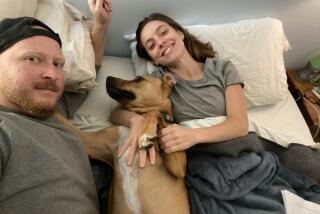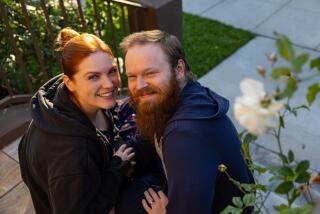Some Get a Second Chance at Motherâs Day
For Gail Gerlich, 33, Motherâs Day will always have a special significance.
In the past, the holiday was painful--a bitter reminder of doctorsâ predictions that she would never bear children.
âEvery Motherâs Day I went through a period of depression. Everywhere I went, there were kids and babies,â said Gerlich, who went through premature menopause at age 18, which meant that her ovaries shut down and stopped releasing eggs.
But Gerlich is celebrating the holiday this year. With the help of her sister and the in-vitro fertilization process, the Granada Hills woman is seven months pregnant.
âWe are ecstatic,â she said.
In in-vitro fertilization, an egg is fertilized in a laboratory and implanted in a motherâs womb. According to estimates from the American Fertility Society, a research organization, between 3,000 and 5,000 children--known as test-tube babies--have been born through this method in the United States since 1981.
The motherâs own eggs are often used in in-vitro fertilization. But Gerlich had no eggs so her sister, Donna Toohey, 34, donated some, which were fertilized in a laboratory with Gerlichâs husbandâs sperm. The fertilized egg was implanted in Gerlichâs uterus.
At a Motherâs Day luncheon in Granada Hills on Saturday, Gerlich and 28 other San Fernando Valley women and their families shared stories about past infertility problems.
The most recent federal estimates are that 2 million to 3 million couples in the United States are unable to have children. And that number is increasing because many couples wait until they are older before attempting to conceive, medical authorities say.
But Dr. Jirair Konilian, the obstetrician and gynecologist who held the luncheon for his patients, said 60% of the infertile couples who seek medical treatment are eventually able to have children.
Sometimes the problem can be treated with antibiotics, hormone and vitamin treatments, fertility drugs or surgery to clear blocked tubes. But many people with more serious medical barriers preventing pregnancy eventually turn to in-vitro fertilization, Konilian said.
âComing home and hearing crying babies is like a dream come true,â said Richard Maberry, the father of twin boys born three months ago through in-vitro fertilization.
Maberry and his wife, Karin, of Agoura, tried for seven years to have children. Karin was told that her tubes were blocked, preventing her eggs from reaching her uterus and being fertilized. She took various drugs and had several surgical procedures to try to correct the problem but still could not become pregnant.
âWe always kept trying whatever new thing came up,â she said. The couple had nearly given up on becoming parents until in-vitro fertilization was suggested.
Treating infertility is an expensive proposition. The battery of tests to diagnose the cause of infertility costs from $4,000 to $5,000 and is rarely covered by California medical insurance policies, Konilian said. For Gerlich, who already knew the cause of her infertility, the procedures to impregnate her cost about $7,000, he said.
Konilian, who received his medical degree from the American University in Beirut in 1979, pioneered the technique of implanting surrogate mothers with fertilized eggs conceived in a laboratory from parentsâ sperm and egg, a procedure not widely practiced.
The procedureâs advantage is that the surrogate mother does not feel that she is giving up her own child, Konilian said, since the baby is the genetic offspring of the mother and father.






